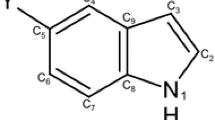Conclusions
-
1.
The electronic and energy indices of neutral, anionic, bipolar, and cationic forms ofβ-hydroxypyridine were calculated by the molecular orbital method in the Hückel approximation.
-
2.
The calculated values of the energy differences between the highest occupied and lowest free molecular orbitals are linearly correlated with the experimental values of the absorption maxima of the long-wave (π →π *) bands of the four forms ofβ-hydroxypyridine.
-
3.
The values obtained for the energies of localization indicate that electrophilic substitution forβ-hydroxypyridine proceeds in the sequence 2>6>4>5, also observed experimentally. The sequence 2>6>4>5 has been predicted for nucleophilic and radical substitution.
-
4.
A comparison of various indices of reactivity gives a basis for concluding that reactions of electrophilic substitution inβ-hydroxypyridine proceed through the formation of an intermediate σ-complex.
Similar content being viewed by others
Literature cited
D. E. Metzler and E. E. Snell, J. Amer. Chem. Soc.,77, 2431 (1955).
L. Paoloni, M. L. Tosato, and M. Cicnitti, Theoret. Chim. Acta (Berlin),14, 221 (1969).
G. G. Dvoryantseva, V. P. Lezina, V. F. Bystrov, T. N. Ul'yanova, G. P. Syrova, and Yu. N. Shemker, Izv. Akad. Nauk SSSR, Ser. Khim., 994 (1968).
É. Streitwieser, The Theory of Molecular Orbitals [Russian translation], Mir (1965).
V. I. Vedeneev, L. V. Gurvich, V. N. Kondrat'ev, V. A. Medvedev, and E. L. Frankevich, Cleavage Energies of Chemical Bonds. Ionization Potentials and Electron Affinities [in Russian], Izd-vo AN SSSR (1962).
J. M. Robertson, Proc. Roy. Soc., (London), A157, 79 (1936).
J. S. Michael Dewar and T. Morita, J. Amer. Chem. Soc.,91, 796 (1969).
W. B. Wright, G. S. D. King, Acta Crystallogr.,6, No. 4, 305 (1953).
Physical Methods in the Chemistry of Heterocyclic Compounds [in Russian], Khimiya (1966).
Pyridine and Derivatives, Interscience Publishers, Vol. 3, New York-London (1964), p. 614.
R. A. Abramovitsch and J. G. Saha, Advances Heterocycl. Chem.,6, 229 (1966).
Author information
Authors and Affiliations
Additional information
Translated from Izvestiya Akademii Nauk SSSR, Seriya Khimicheskaya, No. 10, pp. 2140–2144, October, 1971.
Rights and permissions
About this article
Cite this article
Zaitsev, B.E., Grachev, V.T., Dyumaev, K.M. et al. Electronic structure and reactions of aromatic substitution inβ-hydroxypyridine. Russ Chem Bull 20, 2024–2027 (1971). https://doi.org/10.1007/BF00851242
Received:
Issue Date:
DOI: https://doi.org/10.1007/BF00851242




